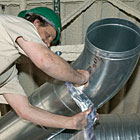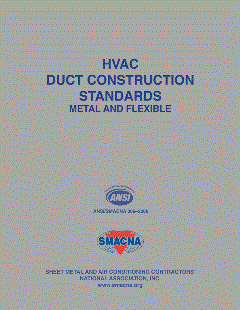
Hardcast recently introduced Foil-Grip 1403-181BFX, a pressure-sensitive sealant that adheres instantly to any duct surface. (Photo courtesy of Hardcast.)
To borrow the slogan for Virginia Slims cigarettes, duct tape has come a long way, baby. Perhaps best known by those outside the HVACR industry as the versatile stalwart of any handyman’s tool kit, duct tape has earned a reputation as the “go-to” tape for fixing everything from bullet holes in World War II aircraft to patching broken automotive fan belts. It’s so versatile that since the 1960s, NASA has sent several rolls along on all of its space flights.
That’s not to say the duct tape of yesterday can be - or should be - used in this industry today. For many reasons, the tape of choice has evolved to meet the demands.
Updated codes and improved standards have helped push for tape improvements.
As a result, on the market today are a wide variety of duct tapes available for HVACR work. And, as a result, it can be challenging to get the right tape for the right job unless it is clearly marked.
SELECTING THE RIGHT ONE
The move in the mid-90s to establish new, consistent national standards for HVAC installation has helped improve system performance and durability. And, duct tape has contributed to the cause.For those unfamiliar, the American National Standard code for flexible duct tape is ANSI/UL181B (Part 1). All duct tapes that meet this standard code are required to be clearly marked with the designation 181B-FX on their plastic coating. Third-party certification organizations, such as Underwriters Laboratories Inc. (UL), provide testing, publish listings, and perform quality audit services for manufacturers of tape products. In regard to rigid duct closure products and systems, the standard code is ANSI/UL181A.
The International Code Council (ICC), a nonprofit organization aimed at developing a single set of comprehensive and coordinated national model construction codes, develops consistent building standards and encourages adoption of those standards by local and regional governing agencies. While most local groups adopt ICC code, some don’t, and this inconsistency can prove difficult for HVACR contractors to maneuver.
“The best guidance that UL can give contractors is to use certified closure products with heating and cooling systems in accordance with ICC and NFPA major installation code requirements,” said Dwayne E. Sloane, principal engineer for air duct closures with UL.
“ICC codes have been adopted by a great majority of states and jurisdictions. The requirement of listed and labeled UL181B-compliant duct tape within the ICC mechanical, energy, and residential codes was a huge advancement. It showed, on a national level, the recognition of the benefits of using tested and certified materials on duct systems.”
ICC sets standards for 85-90 percent of building codes nationally, so ICC code is generally more stringent than local building codes. In Sloan’s estimation, the use of certified duct tape not only demonstrates compliance with code, a contractor should have less rework “and you’ll get a huge performance return for the minor difference in cost.”

Just as a heating or cooling system needs to be installed properly, so does duct tape. The Air Diffusion Council recommends using at least two wraps of duct tape when connecting, joining, and splicing flexible duct. (Photo courtesy of Shurtape Technologies.)
PRODUCT IMPROVEMENTS
Generally speaking, most HVACR contractors spend the bulk of their time focused on the flexible sheeting, support braces, connectors, and airflow - and not necessarily on a less costly tool that can pay big performance dividends: duct tape. When selected to meet or exceed local building codes, and when used correctly, duct tape can reward contractors with fast inspection approvals, less rework, increased efficiency, and enhanced reputation.Just ask the manufacturers of HVACR tape.
“As a percentage of an overall HVAC job, tape doesn’t constitute a lot of cost,” said Roy Cox, HVACR product manager for Shurtape, headquartered in Hickory, N.C. “But its selection and installation probably has the biggest impact on performance.”
To provide lab data as to which duct sealants and tapes last and which are likely to fail, research was conducted at Lawrence Berkeley National Laboratory Environ- mental Energy Technologies Division in the late 1990s.
Its major conclusion was that one should not use duct tape to seal ducts, noting that “specialty tapes” are available for this purpose. The lab defined duct tape as any fabric-based tape with rubber adhesive. The testing done shows that under challenging but realistic conditions, duct tapes become brittle and may fail. Its use in ducts has been prohibited by the state of California and by building codes in most other places in the United States. However, metalized and aluminum tapes, which are supposed to be used by contractors, are still often called “duct tapes.”
Duct tape is surprisingly simple, consisting of three layers. First is the backing or substrate, composed of tightly woven cotton or synthetic mesh; the tighter the weave, the greater the strength and the cleaner the tear. Some cloth-backed duct tapes, such as Shurtape PC 857, carry a tensile strength rating of 27 pounds/inch of width, which means a 1-inch square piece is designed to withstand 27 pounds of pulling force before it breaks.
The backing is then coated with a polyethylene material that protects the mesh from moisture and abrasion. This plastic coating is flexible and allows the tape to adhere better to irregular surfaces. Lastly, an adhesive, traditionally rubber-based, is applied to the substrate to ensure long-term bonding and to increase the adhesive properties of the tape.
One of the biggest changes in the construction of duct tape since it was first introduced is the development of new types of glues to increase adhesion. An evolutionary shift from natural rubber-based adhesives to synthetic adhesives - such as synthetic rubbers, acrylics, and butyls - has greatly increased performance of today’s duct tape.
The introduction of these new adhesives, along with new manufacturing techniques that some companies have adopted to dramatically limit the emission of volatile organic compounds (VOC) and hazardous air pollutants (HAPs), has made duct tape production much more environmentally-friendly, without sacrificing performance.
PROPER INSTALLATION REQUIRED
Just as a heating or cooling system needs to be installed properly, so does duct tape.“Following the industry-approved steps for the proper installation of flexible ductwork is the key to a professional job, but you’d be surprised how many installations are done incorrectly,” said Jack Lagershausen, executive director of the Air Diffusion Council (ADC), a trade group which tries to provide efficient industry standards for the installation, use, and performance of flexible duct products.
The ADC publishes Flexible Duct Performance and Installation Standards as an industry “how to” guide every five years. Called the Green Book, the guide details every step installers need to know, all the way to using at least two wraps of duct tape when connecting, joining, and splicing flexible duct. If followed, the book can save time, rework, and facilitate passing inspections, said Lagershausen.
Increased awareness of global environmental issues and of the need to reduce fuel consumption by making systems more efficient has impacted HVACR tape just as it has all building and construction components. The Energy Performance of Buildings Group at Lawrence Berkeley National Laboratory estimates that each year U.S. residential duct leakage costs consumers $5 billion.
This energy loss is equivalent to the annual oil production from the Arctic National Wildlife Refuge and equals the annual energy consumption of 13 million cars. Tighter, more efficient HVACR systems, requiring greater attention to proper installation and closure, will be the standard for the future.
In addition, a conscious effort to limit emissions that enter the atmosphere during manufacturing has, and will continue to, reduce air pollution. One example of this is tape manufacturer Shurtape, which recently introduced a line of seven HVACR tapes designed to help contractors earn green building points to qualify for Leadership in Energy and Environmental Design (LEED) certification from the U.S. Green Building Council (USGBC). (See sidebar “Newer HVAC Tapes Step in Green Movement, Too” below.)
“Since we began manufacturing tape in 1955, we have had a commitment to reducing the impact of our processes and products on the environment,” said Stephen Shuford, Shurtape’s executive vice president. “Our emphasis on the LEED program is important for us and our customers, who will benefit from the credits, as well as from affiliation with suppliers who demonstrate environmental stewardship.”
Sidebar: The Tape Tale
Duct tape was created by Permacell, formerly a division of Johnson and Johnson, during World War II in the 1940s. That P-69 version, now manufactured by Shurtape, was initially used to cover the seam where the lid met the container on ammunition boxes. The rubberized adhesive on the tape created a virtually water-tight seal, allowing the ammo inside to stay dry, and ready, when shipped overseas.Some say that because of this property of shedding water, it began to be called “duck” tape. With the housing boom after the war, HVAC installers began using it because it was easy to use, and strong. Consumers, seeing the silver gray tape on their heating ducts, and hearing the term “duck”, assumed it was “duct” tape.
Whatever the true source of the tape’s name, the tape now seals ductwork on more than 1 million HVAC systems in new houses throughout the United States each year, closes leakage on more than 40 million residential HVAC systems through upgrades or retrofits each year, and connects tens of thousands of commercial heating and cooling systems annually.
“Most HVACR contractors wouldn’t dream of installing a job without duct tape,” said Roy Cox, HVACR product manager for Shurtape.
Experts in the field agree that duct tape does have its limitations. For instance, it cannot fix the national debt, mend a broken heart, or patch together the meaning of life. On the other hand, we all know the world has never been the same since it came into our hands.
Sidebar: Newer HVAC Tapes Step in Green Movement, Too
Yes, even silver duct tape is going green.Shurtape Technologies(www.shurtape.com) andHardcast(www.hardcast.com), a division of Carlisle Coatings & Waterproofing Inc., recently introduced tapes that can meet Leadership in Energy and Environmental Design (LEED) requirements. LEED, administered by the U.S. Green Building Council (USGBC), is a nationally accepted benchmark for the design, construction, and operation of high-performance green buildings.
Shurtape’s portfolio of HVAC tapes that contribute to LEED credits include:
• AF 100 aluminum foil tape (UL181A-P/B-FX);
• AF 973 aluminum foil tape;
• AF 982 FSK tape;
• DC 181 flex film duct tape (UL181B-FX);
• PC 857 HVAC professional grade duct tape (UL181B-FX);
• PC 609 industrial grade cloth duct tape; and
• LS 300 line set tape (UV resistant).
According to the manufacturer, when these tapes are combined with other reduced volatile organic compound (VOC) adhesives and sealants used throughout a building, that building is eligible to receive credit toward LEED certification. In commercial buildings, the credit is one point; in residential construction, the credit is one-half point.
Shurtape said its manufacturing process, which is considered one of the reasons the HVAC tapes are credit-eligible, predominately uses water-based adhesives that do not emit VOCs. When specifications require the use of solvent-based adhesives, the company said its manufacturing process recaptures and destroys air-borne toxins through regenerative thermal oxidization (RTO), greatly reducing emissions, it said.
“From the installation of our first solvent-recovery system in 1967, to the completion of our two newest plants, we have consistently invested in a greener tomorrow,” said Stephen Shuford, executive vice president at Shurtape.
Hardcast, on the other hand, said its mastic duct sealants that passed the green test include Iron-Grip™ 601, Flex-Grip™ 550, Versa-Grip™ 102, Versa-Grip 181, and Duct-Seal™ 321. All of these products can be used on any LEED-rated project.
In addition to its mastic duct sealants, Hardcast offers a variety of rolled sealants and water-based, duct liner insulation adhesives that are LEED compliant as well. The rolled sealants include Aluma-Grip™ 701, Foil-Grip™ 1402, Foil-Grip™ 1403-181BFX and All-Purpose™ 1602. The LEED-compliant adhesives include Booth-Tack™, Roto-Tack™, Speed-Tack™, Coil-Tack™, and Seal-Tack™.
Hardcast labels its Foil-Grip 1403-181BFX a pressure-sensitive sealant that adheres instantly to any duct surface, eliminating dry/cure time. It said the product “offers superior peel and tensile strengths and has met and exceeded all of Underwriters Laboratories (UL) 181B standards for safety, strength, and adhesion for flex-duct systems.”

Venture Tape said its #1581A tape employs a reformulated adhesive that can be applied in extremely cold temperatures. This new tape is both UL181A-P and UL181B-FX listed and has quickly become a favorite of HVAC contractors because it eliminates the need for the tape to be heated before use in winter climates. (Photo courtesy of Venture Tape.)
Other major HVAC tape manufacturers announced new product developments recently, including:
•Venture Tape(www.venturetape.com) introduced in January of this year a new cold weather tape designed for sealing fiberglass duct board and metal duct. The manufacturer said its #1581 tape employs a reformulated adhesive that can be applied in extremely cold temperatures. This new tape is both UL 181A-P and UL 181B-FX listed and “has quickly become a favorite of HVAC contractors because it eliminates the need for the tape to be heated before use in winter climates.”

Venture’s Cooler Repair Tape is a patented, zero permeability, 5-ply, self-adhesive material, designed to install quickly and easily with no special tools required. Made with cold weather, mold-resistant acrylic adhesive, the manufacturer said the tape is guaranteed to work in the most demanding cold conditions. (Photo courtesy of Venture Tape.)
•Stik-II Products(www.stik-2.com) recently introduced new one-piece duct gaskets designed to improve time and cost savings. The company’s pre-cut gaskets are available in several configurations in stock and custom sizes. It said that innovative die-cut square and rectangle scissor gaskets can be custom made to fit any specified size opening; circle gaskets are available from 4-inch to 24-inch inside diameter. These gaskets offer “a gap-free seal on ductwork for heating and air conditioning units and in metal-to-metal bonding applications,” said the manufacturer.

The Tubolit W SS (white self-seal) polyethylene pipe insulation is a self-sealing closed cell foam with pre-glued sides, designed for quick, convenient application. It is available in the most frequently specified pipe sizes and thicknesses. The manufacturer said installation requires no more than a measuring tool and a knife for cutting. (Photo courtesy of Armacell.)
A key to the effectiveness is the proprietary W Tape, it said. The tape is available in rolls 2-inches wide by 60-feet long. With this new tear-resistant tape, installers “can quickly and easily join seams and securely insulate elbows using standard PVC fittings without any fabrication or liquid adhesives.” It is designed to adhere securely to polyethylene tubes, the company said.
Publication date:10/13/2008







